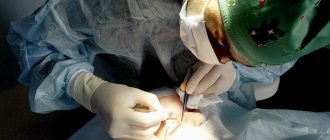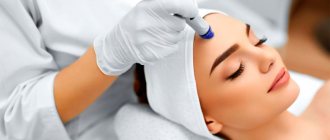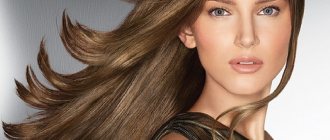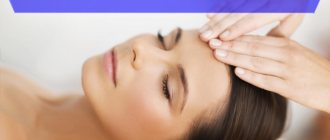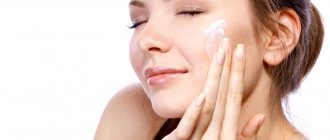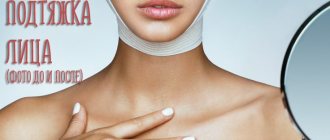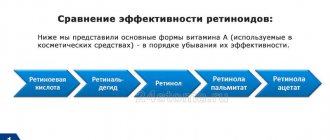Laser facial resurfacing is based on the effect of laser on the facial skin. Leveling the relief of the epidermis is achieved by evaporating soft tissues.
During the procedure, the emitter diffuses deeper into the skin than during chemical peeling.
This eliminates the stratum corneum of the epidermis, and through dynamic cell division, a healthy skin surface is formed.
At the same time, the laser resurfacing technique frees the client from many problems. What can the procedure do?
Characteristics of laser facial resurfacing
Laser facial resurfacing (also known as laser peeling) is a cosmetic procedure that is performed with a laser device and is aimed at removing the dead layer of epithelium.
This is a fairly serious procedure that can cause irreversible consequences: scar formation, hypo- or hyperpigmentation of the skin, loss of fat, etc.
This is why laser resurfacing should only be carried out by an experienced specialist.
In addition to minimizing unwanted age-related changes and eliminating scars, laser therapy activates collagen production.
This happens due to the intensification of natural processes caused by the procedure.
Laser rejuvenation can be safely classified as a progressive method. Every year more and more people undergo this procedure.
Plastic surgeon Barry Weintraub
Manipulation leads to increased blood flow. The difference between gentle laser resurfacing is that the layer of epidermis is removed only from certain areas of the skin.
Exposure of the beam only to microzones reduces the time period allotted for recovery at the end of the skin procedure.
In terms of performance and effectiveness, a cosmetic laser technique can compete with a surgical procedure aimed at correcting defects on the face.
Which is better: chemical peeling or laser resurfacing (comparison of procedures)
comparison table
| Chemical peeling (deep) | Laser resurfacing | |
| Method of influence | Destruction of cells using different chemical compounds | Destruction by laser beam |
| Features of the procedure | Destruction of all cells of the skin layer | Spot impact |
| Rehabilitation | Long-term, complex, painful – 10-18 days | Fast, with minimal discomfort – 3-7 days |
| Update rate | Recovery is gradual, with the formation of a crust | Microtraumas are created that force the body to quickly recover |
| Collateral effect | Regeneration only | Regeneration and production of collagen, elastin |
Read more about the chemical peeling procedure.
What laser is used (CO2 or erbium)?
There are 2 types of laser used for resurfacing:
- Carbon dioxide (CO2). Remarkably polishes scars, stretch marks, eliminates skin tumors. The disadvantage of its use is the strong heating (10 µm) of the treated micro-areas. As a result, the skin occasionally suffers from burns, which affects the prolongation of healing.
- Erbium. It emits (5 microns) several micro-rays at once, so the outgoing heat is dissipated and does not cause burning on sensitive skin. This beam helps to achieve a lifting effect on the delicate skin surface of the eyelids and neck.
The rehabilitation period after an erbium laser is half as long when compared with a CO2 laser. In addition, it can be used to treat thin, dry leather.
Dermatologic surgeon Corey Frucht
The laser resurfacing procedure on the face is practically painless for the patient, since gel anesthesia or anesthesia with the use of the drug orally is chosen.
What is a fractional laser procedure?
The cosmetology field is developing more and more actively over time. Methods for treating various structural disorders of the epidermis are not only surgical or traditional interventions, but also conservative hardware ones. Various physical phenomena are used to change the structure of the skin:
- Light.
- Laser.
- Ultrasound.
- Currents.
A fractional laser is a point beam of a large amount of energy that heats the inside and extracellular fluid at a certain depth (depending on the wavelength), initiating evaporation and thermal burn or the release of biologically active substances.
The cells surrounding the lesion, in response to damage, begin to secrete special proteins that activate the destruction of non-viable cells and the reparative abilities of the cells of the basal layer. At the site of the lesion, macrophages migrate, which absorb cellular debris, releasing chemically active substances that also trigger the recovery process. It goes away within 1–2 weeks, resulting in the complete restoration of the skin structure.
For a visual representation of this process, you can familiarize yourself with a large number of resources, rich photos and videos of this treatment method.
Kinds
Depending on the method of exposure, ablative and non-ablative lasers are distinguished. The main distinguishing feature between them is the ability to initiate ablation (evaporation) of the outer layer of the skin.
Due to its long wavelength, an ablative laser has low penetrating ability; therefore, all the energy accumulates in the surface layers relative to the beam and has a damaging effect in the form of cell evaporation. The result is a deep wound that exposes the inner layers of skin. Currently, carbon dioxide laser is used.
Non-ablative lasers have a shorter wavelength, which increases penetration and allows you to choose the depth of the effect. Unlike ablative, cell destruction does not occur. A typical representative of this type is the erbium laser.
As a result of exposure to fractional lasers, they stimulate the production of specific proteins that perform the following roles:
- Stimulates the growth of connective tissue and the basal layer of skin cells.
- Initiation of apoptosis of damaged cells.
Fractional laser methods are used in the treatment of the following diseases:
- Disorders of skin pigmentation (melasma, lentigo).
- Structural pathologies of the epidermal layer of the skin.
- Pore expansion.
- Scarring.
- Stretch marks.
- Significant increase in the number of folds.
- Age-related changes (significant decrease in turgor with the formation of wrinkles of moderate depth).
- Acne and post-acne, stretch marks.
Contraindications
The laser has a significant effect not only on a limited area of the skin, but also on the entire body, causing damage. To successfully restore a damaged structure, various systems are involved, therefore, for high efficiency of the procedure with a low probability of unwanted effects, it is not recommended to perform this procedure for people with certain pathologies.
Among the diseases and conditions, there are those in which under no circumstances it is impossible to carry out the procedure (absolute) and those in which it is possible to carry out photothermolysis after cupping (relative). The absolute ones include:
- Epilepsy.
- Pregnancy and lactation period of feeding a child.
- Presence of an infectious disease.
- Immunosuppressive conditions.
- Tumor diseases.
- Skin diseases (vitiligo, atopic dermatitis, psoriasis).
- Taking retinoids orally.
- Tendency to the appearance of hypertrophic scars.
Relative contraindications include:
- Allergic reactions to taking local analgesics.
- Disruption of the excretory system.
- Similar procedures performed in less than 2–3 months for the dermal layer and in 10 days for the epidermal layer of the skin.
- Autoimmune connective tissue diseases.
Complications
After laser resurfacing of the face, a burn occurs, characterized by pain, burning, and itching. Undesirable pathological symptoms after a fractional laser procedure can occur either if the principles of therapy are not followed, or if the patient ignores adequate postoperative skin care. The risk of complications is extremely unlikely.
Among the pathological reactions are:
- Increased skin pigmentation due to neglect of adequate care in the field of protection from exposure to ultraviolet radiation.
- The appearance of areas of depigmentation when melanocytes are damaged due to an inadequate radiation dose.
- The development of a serious burn as a result of a violation of the principles of therapy by a doctor with the appearance of a red spot (erythematous lesion).
- The appearance of scars or cicatrices as a result of a predisposition to keloid formation.
- Exacerbation of herpes and the onset of bacterial infection.
- The occurrence of contact dermatitis (swelling, inflammation).
Advantages and disadvantages of laser resurfacing
There are different methods of laser rejuvenation (biorevitalization, blepharoplasty, etc.). They all have their pros and cons. This also applies to laser resurfacing.
At the end of the cosmetic procedure, firmness and smoothness of the skin surface are quickly achieved. The rash, visible wrinkles and irregularities “run away” from the epidermis.
Obtaining a positive result is facilitated by the professionalism of the cosmetologist, who will select the right type of laser for a specific patient.
The erbium laser ER:YAG is gaining particular popularity.
Plastic surgeon Smita Ramanadham
5 main advantages
- Slowing down the skin aging process. The most pronounced effect appears in the area of the nasolabial furrows and near the eyes.
- Elimination of skin unevenness in the form of scars, scars, and age-related dents. Irregularities disappear under the action of grinding. Elimination of such problems occurs upon completion of the course of procedures. Pimples disappear after one session.
- An improvement in tone appears at the end of the recovery period. The face acquires a light, uniform shade without the presence of freckles or pigmentation.
- The narrowing of pores is achieved by updating and strengthening natural processes.
- New cells are formed that are not clogged with fat and dirt deposits.
Conventional laser resurfacing and fractional laser rejuvenation differ from each other. In the first case, the entire area is processed. If fractional photothermolysis (as it is also called) is carried out, specific zones (fractions) are processed.
Plastic surgeon Injili Kitto
Cons of the procedure
- Painful sensations during the event that are not completely removed by local anesthesiology. General anesthesia is rarely used for laser resurfacing.
- Not an easy rehabilitation (2-4 weeks), requiring care for the skin surface established after the course. It is necessary to use prescribed creams, ointments, and sometimes anesthetics. At the end of the activities, the patient may experience: itching of the facial skin, increased body temperature.
A detailed consultation with a cosmetologist will help reduce the possibility of unwanted consequences after sessions.
The specialist will minimize risks and determine whether the client has any contraindications to laser facial resurfacing.
Prohibitions for the procedure include herpes, diabetes, psoriasis, and the acute phase of a chronic disease. Those with wounds on the epidermis, pregnant women and breastfeeding women will be temporarily refused sessions.
Laser resurfacing is attractive because it achieves a multifaceted effect without damaging the skin with injections with synthetic products.
Indications and contraindications for the procedure
- Post-acne - spots (scars) left after acne;
- Acne (pimples);
- Presence of scars, skin defects (atrophic, keloid scars);
- Fine facial wrinkles, age-related changes, sagging skin;
- Enlarged pores, vascular mesh with a depth of up to 4 mm, a diameter of up to 2 mm;
- Stretch marks, stretch marks, defects after chickenpox, cesarean section;
- Hyperpigmentation.
Contraindications are age under 18 years, pregnancy. The procedure should be abandoned if you have cancer, viral diseases, skin infections, or diabetes. In case of exacerbation of chronic diseases, photodermatitis and severe tanning, it is better to reschedule the session. For uncompensated heart problems and epilepsy, resurfacing is contraindicated.
How is laser resurfacing done?
The manipulation is carried out by a plastic surgeon or cosmetologist in the following sequence:
- Having assessed the condition of the facial skin, the doctor determines the type of laser for the event and the type of anesthesia.
- First, he cleans the skin surface 60 minutes before the event with an antiseptic and provides anesthesia.
- Next, the surgeon (cosmetologist) puts on protective glasses for himself and the client and begins grinding. Technologically, a cycle is maintained that is aimed at achieving the goal.
Tell us during your consultation about your preferred result on the specified area of the face.
Possible side effects
Facial rejuvenation with laser
Laser facial resurfacing after acne, to eliminate pigmentation or for anti-aging purposes is a fairly safe procedure.
Expected side effects include:
- erythema,
- edema,
- hyperpigmentation of the treated area.
All these effects disappear without additional intervention during the recovery period. In case of hyperpigmentation, the rehabilitation process can be accelerated by applying special whitening preparations to the skin (consultation with a doctor is required).
Another negative side effect is infection of renewed and susceptible skin. Proper care and antiviral therapy will help to avoid such consequences.
It is worth remembering that secondary infection often leads to severe scarring, so all doctor’s recommendations should be taken responsibly.
Deep polishing of wrinkles
This grinding after the preparatory period occurs in the following sequence:
- initial movements of the laser eliminate the outer layer - the epidermis;
- subsequent slow advances of the beam carry out layer-by-layer evaporation of the dermis from different main zones;
- The final laser passes reduce the depth of the nasolabial folds.
This order is followed three times during the procedure. The beginning of each re-treatment is accompanied by the application of an anesthetic gel.
Redness first appears on the treated area of the skin, and at the final stage the skin becomes white.
The 3rd laser treatment sometimes causes blood droplets to appear. The laser vaporizes the skin around the eyes, the collagen produced fills the wrinkled cavities, so the face becomes smooth.
At the end of the session, it is necessary to use healing ointments, painkillers (if necessary), and occasionally use dressings.
The skin recovers in 2-3 weeks. It is permissible to start re-polishing with a laser no earlier than 3-4 months after the incident.
Plastic surgeon Kenneth Francis
Impact zones
Laser resurfacing is most often used on the face - on the forehead, eyelids and skin around the eyes, lips, periorbital area, nose, neck. The devices work well on different types of scars, even on the delicate skin of the eyelids. The laser removes the top layer of skin where acne scars are located. The area is updated and acquires a normal color.
This is a safe and effective way to combat pigmentation, freckles, and lentigo. The beam is applied to the spot, removing cells that contain a large amount of melanin. In this case, healthy cells are not affected. Instead of a spot, smooth, light skin is formed. Learn more about the laser pigmentation removal procedure.
Lasers are successfully used to combat spider veins. The effect is only on hemoglobin, the vessels are affected pointwise.
Resurfacing is also used to eliminate defects on the body: abdomen, legs, arms, chest (décolleté), back and buttocks. The scars are excised with a beam - the defect is eliminated in layers. To remove a fresh scar, 1 procedure is enough. If stretch marks appear, the most effective way to combat them is laser. After exposure, restoration processes are launched, the skin is smoothed, problems disappear.
What does laser resurfacing of facial scars provide?
Scarring of facial tissue occurs after traumatic situations, surgical interventions and acne on the skin. A carbon dioxide laser is often chosen for resurfacing.
The exception is delicate areas; professionals use the erbium option to carry out the procedure on them.
- Immediately after the procedure, the skin takes on a reddened and swollen appearance.
- A day later, yellow-brown crusts appear on the laser work area. After 5-7 days they disappear on their own, and the swelling disappears.
- After the same period, you can see the result, which is usually positive, which largely depends on the condition of the scar tissue. But at the very least, the edges of the scar will become blurred and its tone will fade. Gradually, even a wide scar will leave no trace on your face.
At the end of the procedure, a burning sensation occurs even after preliminary use of an anesthetic. An intravenous anesthetic is more effective for eliminating a scar on the neck.
Fractional grinding
Fractional facial resurfacing is a type of laser resurfacing, in the process there is a targeted effect on the skin, while nearby areas are not traumatized, scarring occurs faster, and the likelihood of side effects is reduced.
During the procedure, the laser is divided into very thin beams, and they hit the skin area at equal intervals, as a result of which a kind of mesh is formed.
Indications:
- Age-related changes, wrinkles.
- Wrinkles around the eyes.
- Cuperosis.
- Circles under the eyes.
- Fuzzy facial contour.
- Premature and actinic aging of the skin.
- Acne marks.
- Loss of skin elasticity.
- Unevenness, dull skin tone.
Contraindications:
- Presence of photophobia.
- Taking antithrombotic drugs.
- Epilepsy.
- Oncological diseases.
- Tanned and dark skin.
- Wearing a pacemaker.
- Taking medications that increase photosensitivity.
- History of pathological scars.
- Infections.
- Colds.
- Taking 13cis-retinoic acid six months before resurfacing.
- Pregnancy.
- Diabetes.
Fractional laser resurfacing removes 30% of the epithelium, while it is removed pointwise and not entirely.
7 days before the procedure you should start using a moisturizer, 3 days before the procedure you should take a herpes medication.
The procedure always begins with anesthesia, an anesthetic drug is injected or applied. Then the laser begins to work, dissipating, its numerous rays penetrate deep into the skin. It is mandatory to alternate between areas of tissue without changes and areas that were subject to thermal damage.
Healthy and intact tissues stimulate cellular immunity, and damaged cells begin to restore new blood vessels. The perforated areas heal, due to which the collagen skin framework is restored.
After the procedure:
- the skin is tightened;
- contours are restored;
- scars, scars and wrinkles become less noticeable;
- complexion improves.
Healing is faster than after laser resurfacing - in 7-14 days. After the procedure, it is recommended to splash thermal water on your face, take analgesics, and smear your face with a moisturizing and healing cream.
Elimination of pigmentation
Skin pigments are familiar to 50% of women. The use of creams, decoctions, masks, if it helps to eliminate pigmentation, does so after many years.
And laser resurfacing combats this phenomenon quickly and effectively, since the laser beam, together with the epidermis, also destroys the melanin pigment.
Its excess affects the change in skin color. During the procedure, the colored spots melt. In return, cells are formed that produce and accumulate the natural amount of pigment.
As a rule, 7-10 days after one session the patient becomes the owner of an even skin color.
To get rid of pronounced spots and freckles, a repeat procedure may be required. But even after the initial sanding is completed, their color fades.
Rehabilitation after manipulation includes avoiding sunbathing and using tanning creams.
The result after grinding increases over time. This will require you to wait about a month.
Beautician Sean Patel
Anti-pigmentation polishing
Laser resurfacing of hyperpigmentation is comparable to a burn. The deeper it is, the greater the effect.
Removal of pigment spots takes place in several stages:
- Skin preparation . For 2 weeks, do not expose the area with problem skin to ultraviolet radiation. If there is hair on the skin, it must be shaved before manipulation. Before resurfacing, the doctor will apply a moisturizing cream to the treated area to prepare the skin for laser treatment.
- Direct laser action. The doctor selects the length of the beam and the duration of its radiation. Using a special device, the cosmetologist directs the beam to the desired area. The laser unit burns the affected skin at high speed. As a result, elastane and collagen begin to be produced.
- Rehabilitation . For the first 15 days you should not be exposed to ultraviolet rays or go to the solarium. It is necessary to smear the skin with sunscreens that have a high SPF level. The first day there will be slight redness and slight swelling of the integument. You cannot use cosmetics. It is best to treat the skin with panthenol-containing ointments for rapid healing of the burned area.
Face resurfacing (before and after photos are assessed after 20 days) can cause complications. During rehabilitation, a person needs to be observed by a doctor.
Negative effects of laser resurfacing
The skin surface on the face after laser resurfacing sometimes does not please the patient with its appearance. This happens if before the manipulation the skin with the scar was in a deplorable condition.
The depth of wrinkles and the size of pigment formation also affect the result. But a professional will choose the right technique for processing the epidermis and conduct the event at a high level.
It upsets patients that after resurfacing with a carbon dioxide laser, spots and burns sometimes appear on the skin. But there is an erbium laser, and it is safer and more reliable.
You should accept the imperfect appearance of your skin after the procedure for a week. Swelling, wounds, peeling will go away, and the effect of grinding will please you.
If the skin has healed, but the result worsens, you should consult a doctor. Communication with a specialist should not be postponed when:
- Burns and blisters plague me. They are formed when the intense laser exposure is exceeded in sensitive areas.
- Pigmentation forms. This rarely happens due to reasons that are not fully understood. One of the assumptions is damage to the laser dyeing.
- Purulent inflammation occurs. And this is the fault of the patient, who, after finishing the grinding, ignored proper facial skin care. Therefore, it is forbidden to scrape off the crusts that appear: they are eliminated naturally. And the ointments will prevent tissue contamination - they will speed up healing.
Information about the type of laser will be provided to the patient before the start of the session by a professional cosmetologist. He is obliged to provide the client with recommendations for the recovery period, which will allow him to avoid a negative result after grinding.
What is good about laser resurfacing: pros and cons of the procedure
- The result is noticeable immediately.
After the first procedure, patients note a positive effect. - Safely.
The laser beam is precisely directed to the defect, without capturing healthy tissue. In addition, modern laser equipment is equipped with a cooling system that reduces the patient’s discomfort, and before the session the skin is lubricated with an anesthetic cream. - Fast recovery.
The rehabilitation period takes only 3-5 days (on average). Swelling and redness disappear on their own within a few days, after which the patient can return to their normal rhythm of life. You just need to follow the recommendations - refuse to visit the gym, baths, saunas, and do not sunbathe. - Versatility.
Laser resurfacing is used to eliminate aesthetic imperfections on the skin of the face and body, as well as to eliminate the consequences of sudden weight loss (stretch marks), cesarean section and other operations.
Sanding is perfect if you want to shine and look especially attractive at an event. This is an ideal choice for aging skin, as well as for cases where deep resurfacing of scars is needed.
The method is significantly more effective than home peels – you will immediately notice the difference. Those who have had Botox injections should take into account that the effectiveness of the therapy will decrease.
Disadvantages of laser resurfacing
After the procedure, a burning sensation occurs (like after a sunburn). It goes away quite quickly, within a few hours.
In the first 2-3 days after resurfacing, severe swelling is possible.
Positive results from the procedure
At the end of a well-conducted event, patients note:
- noticeable leveling of scar tissue, reducing the depth and lightening of scars, disappearance of age-related irregularities on the skin;
- leveling wrinkles on the face and increasing the elasticity of the skin;
- improving the overall condition of the skin in the form of narrowing pores, evening out color, destroying age spots and returning a healthy glow to the dermis.
The transformation will occur 7-10 days after the end of laser resurfacing.
To speed up your recovery, many doctors will advise you to undergo a plasma lifting procedure. This is the administration of platelet-rich plasma, which is obtained from the plasma of the person himself.
Dermatologist Brian Chen
FAQ
Are there age restrictions for the procedure? Can sanding be done for children?
There are no age restrictions for adults (over 18 years old); children cannot undergo grinding.
Does laser resurfacing hurt?
The use of modern equipment with cooling systems and special anesthetics makes the procedure minimally painful.
What is the difference between laser peeling and laser resurfacing?
The difference is in the intensity of the impact. Peeling has a superficial effect, grinding has a deep effect, capturing the tissue structure. Peeling cannot remove scars and scars, but resurfacing can do this.
How many procedures do you need to do to achieve the effect?
To get the desired result, it is necessary to carry out from 1 to 7 procedures. The amount depends on the task, skin condition, individual characteristics of the patient and the type of laser.
How often can I have laser resurfacing on my face or body?
The frequency depends on the type of laser used. Can range from 1 time every 2 weeks to 1 time every 2 months.
Cost of rejuvenation
The price of laser rejuvenation includes several items: type of laser, level of resurfacing, number of procedures, financial policy and location of the clinic in a particular region.
So, in the capital of the Russian Federation, 1 procedure costs starting from 20 thousand rubles. In the provinces, for example in Voronezh, 1 session will cost at least 10 thousand rubles.
For complete facial resurfacing with a laser for 1 manipulation, you will have to pay an average of 25 thousand - 60 thousand rubles.
Cost of services
| View | Plot | Average cost (RUB) |
| Fractional mesotherapy | Face | 24500 |
| Neck | 18500 | |
| Cleavage | 18900 | |
| Face, neck | 29400 | |
| Neck, décolleté | 29400 | |
| Brushes | 15900 | |
| Laser scar resurfacing | 5 cm2 | 3500 |
| From 5 cm2 to 10 cm2 | 5500 | |
| From 10 cm2 to 20 cm2 | 8500 | |
| Over 20 cm2 | 1200 | |
| Laser therapy for rosacea, rosacea | Face | 8200 |
| Nasolabial triangle | 3800 | |
| Chin | 4100 | |
| Cheekbones | 5000 | |
| Cheeks | 6000 | |
| Pigmentation | Face | 8000 |
| Forehead | 4300 | |
| Nasolabial triangle | 3700 | |
| Chin | 4000 | |
| Diamond grinding | Face | 1200 |
| Face, neck, décolleté | 3800 | |
| Brushes | 1500 |
The cost will change depending on the region where the clinic is located and the specialist chosen. The best option would be a consultation a few days before the procedure, which will not only allow you to become familiar with the cost, but will also enable the specialist to assess the condition of the patient’s skin.
Don’t miss the most popular article in the section: Plasmolifting of the face - what it is, how it is carried out, results, photos before and after the procedure.
Reviews
ANASTASIA, 31 YEARS OLD, SARATOV:
“Because of my wide pores, after much deliberation, I decided to have laser resurfacing. And the procedure lived up to expectations. The skin looks younger and regains its lost smoothness.”
LYUDMILA, 43 YEARS OLD, LIPETSK:
“The scars on my face are from acne I had in my youth.
Blurring the tone increased the severity of the flaws. And laser peeling restored the aesthetic appearance of the face. The skin is smooth and fresh.”
VERONIKA, 26 YEARS OLD, EKATERINBURG:
“I camouflaged my post-acne long and hard, but to no avail.
So I went for laser resurfacing. Recovery lasted 17 days, after the incident I showed up to my friends for the first time. They were delighted to note that the acne pits were barely noticeable. And as the doctor said, they will go away completely after another procedure, which I will undergo in a month.”
Reviews about the procedures
After mechanical cleansing of the face, 70 out of 100 patients develop herpes. Failure to follow recommendations, in particular taking antibiotics, can lead to infection.
Patients also note the duration of the procedure (from 15 minutes to 1 hour), pain after surgery, including taking analgesics, and prolonged redness of the skin (up to 6 months). The result after the procedure reaches almost 90%, with severe skin damage (scars, post-acne, kyloid scars) - up to 70-80%.
Diamond skin resurfacing does not provide the same results in removing scars and scars as dermabrasion (mechanical cleaning), but is very effective in combating signs of aging and pigmentation. The result reaches 95%. The downside, judging by the reviews of patients, is the cost of this procedure. It is also worth noting that to achieve the best result, you need to do from 5 to 8 procedures.
If the laser (fractional) procedure is performed repeatedly, the skin tone is evened out, pores are narrowed, wrinkles are eliminated, and the skin is toned. Based on patient reviews, we can conclude that the procedure is unpleasant; during the operation, a smell reminiscent of burnt skin or hair is felt.
Some women were left with traces from the laser, in the form of a grid. Many patients began to experience redness, and when the temperature changed, the skin became more sensitive. The procedure lasts from 15 to 40 minutes. They also note a fairly high price. Efficiency reaches 70-80%.
How effective facial resurfacing is, photos and reviews from patients can always be found out at an appointment with a doctor. Age-related changes and the influence of external factors do not bypass anyone. Modern cosmetology offers the use of effective procedures for skin deformations.
In most cases, women turn to face resurfacing of any type, but the procedure is also effective for men’s skin. Most patients find the difference before and after the procedure to be worth the discomfort.
Article design: Mila Friedan
Expert opinion
- Cosmetologist
- Surgeon
Anna Avaliani
practicing cosmetologist
With the help of laser resurfacing, you can really make the wrinkles on your face smaller and your skin smoother. In addition, after such a procedure, a lifting effect is observed. The session is carried out without pain.
Aisha Baron
plastic surgeon
To perform this manipulation, local anesthesia is used, which is why people tolerate it well.
The session itself lasts from a quarter of an hour to half an hour. Do not be alarmed by swelling and redness, as this is a normal reaction. Somewhere on the 3rd day, crusts form that cannot be removed yourself; they will fall off on their own in 10 days. Despite the considerable budget, laser facial resurfacing is an effective technique. The patient who applies for the procedure receives new, younger-looking skin. The main thing is to find an experienced specialist and quality equipment.
Tips for skin care after the procedure for speedy healing
We use modern equipment that shortens the rehabilitation period. To ensure healing occurs quickly and with minimal discomfort, you need to cool the skin. For this purpose, use cold compresses every 2-4 hours.
To relieve swelling, hold your head higher. It is better to sleep on a high pillow. Drink more water to maintain fluid balance.
A moisturizer, which is best stored in the refrigerator, helps relieve the feeling of tight skin. The additional coolness is perceived favorably by the skin. You can use decorative cosmetics only after complete healing.
What and how to wash your face after laser facial resurfacing?
For the first three days, it is better to refrain from washing your face with tap water. In the first week, it is recommended to wash your face with saline solution, which is sold in a pharmacy, thermal water or bottled water. Movements should be light and neat. To avoid damaging your skin, DO NOT wash your face with cold or hot water.
Care and recovery after laser peeling
All patients who have agreed to undergo laser resurfacing must refrain from using cosmetics and washing their face during the first week. Compliance with such a recommendation will eliminate complications. In addition, over the next four months, before going outside, a person must apply a special cream to the treated area that has a minimum sun protection level of 50. If the sun's rays hit unprotected skin, this can lead to pigmentation. Please note that during the first two to three weeks the following signs may be observed on the treated area of skin:
- crusts, blisters, peeling of the skin;
- redness, increased pain threshold of facial skin.
Based on website materials: https://clinic-ldf.ru/


